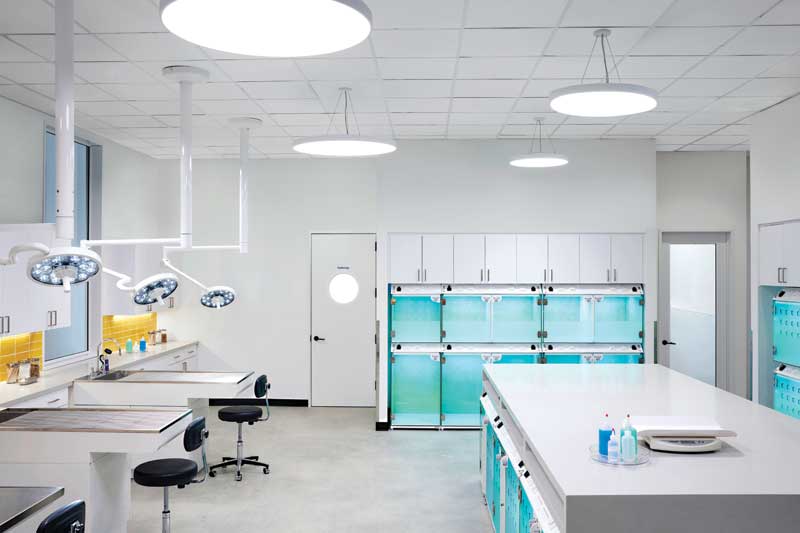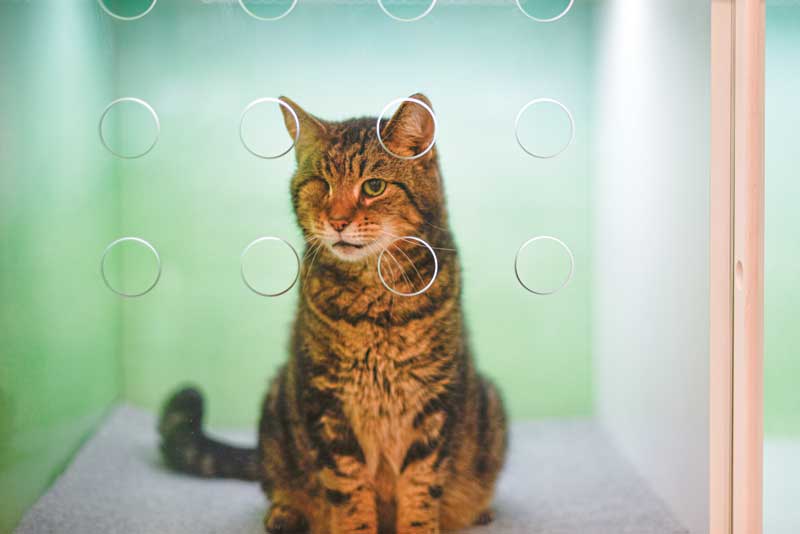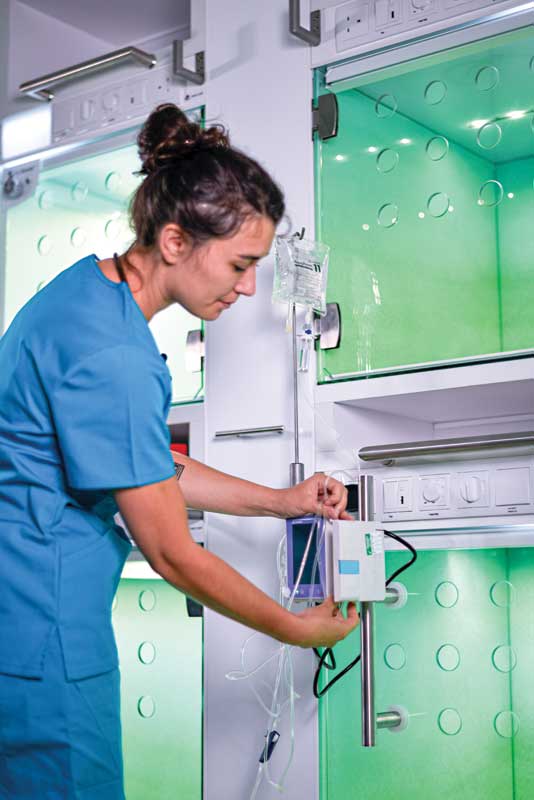
Clinic layout and environment have been highlighted as “significant barrier(s)” when it comes to improving animal welfare in veterinary practices.1 The physical features of said environment–waiting room, treatment area, housing, furniture, and wall colors–can influence animal experience.1
Looking at the example of shelters, the design of facility has repercussions on disease levels, behavioral health, and staffing needs. Poor design can increase stress and illness of staff and animals; conversely, well-designed facilities provide for “animal health and wellness with maximum efficiency.”2
Multiple veterinary associations have identified the design and management of practice environment and the need for a suitable environment as key animal welfare needs.3,4 The World Small Animal Veterinary Association (WSAVA) states, “patients should be provided with an environment that meets their species-specific physical and behavioral needs,” and makes recommendations that encapsulate noise levels, kennels and cages, flooring, wall paint color, and smell.4
When a single visit to your clinic could have a dramatic impact on a pet’s long-term behavioral well-being, you want to make sure patients and owners alike have the best possible experience. In addition, continual stress in the veterinary environment can have adverse effects on immune function, rate of recovery, and increase risk of injury to staff.
Ignoring the impact clinic design has on clients, patients, and staff is a missed opportunity. Designing a clinic that prioritizes back of clinic as much as front of house is essential to future-proofing your business–and it is vital it meets not only your needs, but those of your clients, as well.
What are the latest design trends?
Glass windows
A growing trend in recent years is that of literal transparency–glass windows.5 This unique offering allows pet owners to see into consult rooms, recovery wards, and other back of house areas.
More than just aesthetic appeal, it poses a benefit for clients–they can view the care and quality work being carried out, helping to improve levels of satisfaction and trust. Statistics show between 10 and 78 percent of dogs become stressed or fearful in clinics;6 owners want to know what is happening to their pets and witness compassionate interactions between animal and staff for themselves.
An example is Modern Animal, a Californian veterinary startup, whose West Hollywood clinic is designed in such a way people can see through it “from one end to the other.”5 Head of medicine, Christie Long, DVM, says this has the additional benefit of promoting expertise of veterinary staff. Further, transparency allows for ease of patient monitoring by staff.

Waiting rooms
Another trend concerns waiting rooms, and their changing importance. There is conversation they will “go away” altogether,5 whereas other professionals suggest separating species from the get-go4–one waiting room for dogs and another for cats. This provides an opportunity for reducing stress in anxious pets–exterior doors that access examination rooms means animals do not come into contact with others in a waiting room.
In the case of North Lakes Veterinary Hospital in Brisbane, Australia, pets and owners arrive at the car park stretched along the side of the building, which provides them with the shortest and safest passage from car to clinic.7 Although a waiting room is available, a contained garden offers an alternative space for larger or more aggressive animals.
Lighting
Lighting is a recommendation from WSAVA Animal Welfare Guidelines.4 In terms of trends, a move to natural lighting is being seen. Although fluorescent lighting often marks the cheaper option, it may restrict access to particular wavelengths of light needed for optimal animal well-being.8 Daylighting in animal wards, treatment, and exam spaces are part of the Fear Free checklist–all designed to prevent and alleviate fear, anxiety and stress in pets. Where natural daylight is difficult, softer LED lighting provides an alternative. Outside light in treatment rooms makes it feel more connected to the natural environment; North Lakes Veterinary Hospital finds specialist consultation rooms benefit from northern light.7
Color
As in any matter of design, color–or the lack thereof–is key. Having color guidelines when designing or redesigning a clinic help shape low-stress hospital environments; softer shades can reduce the stress animals experience at the vet.9 In fact, studies say in terms of minimizing stress for patients in veterinary hospitals, it may “behoove veterinarians to paint or decorate their practice in colors that are positively perceived by dogs and cats”10–suggesting softer interior design hues and advising against “visually jarring” bright whites.
Acoustics
Noise mitigation also plays an essential role in improving animal welfare in a veterinary environment. The sound of a single dog barking can reach levels of over 100 dBA it has been found to disrupt dog rest in veterinary intensive care units (ICUs) and reduce dog hearing ability in animal shelters.11 Noises like these are also considered aversive and threatening to cats, and act as a potential stressor. Research recommends reducing such environmental background noise.12
Excessive noise can also cause stress and hearing damage to clinic staff–the peak sound levels of two veterinary ICUs were found to reach astonishing noise levels; 20-200 percent louder than regulations from the U.S. Environmental Protection Agency (EPA).11 Reducing these types of disruptive noise can be achieved through proper design, as well as construction and
materials selected.13
Integrating back and front of house
Although the latest trends in clinic design improve client perception and animal experience, it seems the further back we go within the clinic, the less likely we are to see changes. Specifically, clinical housing–kennels–is seen as an area that could cause high stress,10 even though enclosures for overnight stays should be designed to reduce fear and anxiety as much as possible.
When it comes to the basic requirements of kenneled animals, these include:
- Warmth, comfort and security
- Company and mental stimulation
- Protection from disease and injury
- Protection from fear and distress14
In addition, kennels need to be an appropriate size for each animal–with the ability to stand up and turn around naturally, and to stretch.4 Cleanliness and maintenance is paramount; these procedures should not be intrusive and should allow for undisturbed rest.
Regardless of these needs, animal housing has seen little evolution over the years–remaining relatively stagnant since 1959, when an animal care panel specified stainless steel type 304 as the type that should be used for cage construction.15 There has been little in the realm of “trends” since, for kennels.
Arguments can be made for the material’s high tensile strength, as well as the fact stainless steel kennels are considered both secure and durable. However, they are particularly noisy–and we have seen what impact noise can have on pets’ welfare. The banging of steel doors can disrupt much-needed sleep; this may induce stress to the point of compromising an animal’s immune system.2 The clanging, resonant material can reach potentially harmful decibels of over 90.2
There are other material alternatives, but each comes with their own notable disadvantages. Wood may be inexpensive but is impossible to clean properly and is not known for being hard-wearing. Concrete also boasts low cost–and unlike wood, is heavy duty–but is markedly cold. Fiberglass and plastic are easy to clean but have issues with not being particularly hard-wearing.14
In that case, how do we advance kennels? It is not so much a design trend, as it is updating and advancing the current (yet dated) norm–although, the aesthetic appearance of kennels does have benefits.
To start, kennels should be minimizing noise. Research recommends veterinarians implement noise-reducing materials like laminate surfaces, ceramic tiles, acoustic ceiling tiles, and glass cages.6 The benefit of these materials is they reduce audible stimuli, in turn, decreasing stress levels for patients and improving the overall veterinary experience for all.
In this instance, glass kennels align with a wider trend–that of “transparency.” In addition, glass kennels allow for easy monitoring as well as offering improved viewing for the animal, to create a calmer and more relaxing environment. Lighting is important here, too – particularly in terms of mimicking natural daylight, and helping maintain an animal’s circadian rhythm. Improved aesthetics can make a difference on experience–the “jail like” look of stainless steel has been found to deter potential adopters in the case of shelters.16
Well-designed accommodation also enables improved standards of husbandry. With this comes healthier animal patients that are more likely to display natural behaviors.17
When we advance kenneling, we turn it from an area of high stress to a tool that minimizes stress; when patients are more settled, client confidence is also improved. In turn, your business and your team also benefit–clients are more likely to bring their pets back, and said pets are likely to be more relaxed and compliant.10
Kennels are undeniably a back of house essential, with the ability to impact pets, owners, and staff. Similar to your clinic design, your kennels need to be future-proofed. As we’ve seen, the current choice for kennels is steeped in the past. An alternative is well overdue–one that is visually appealing, made with noise-reducing materials, colors and lighting that aid with stress reduction, and ties in with the wider modern clinic design.

Conclusion
There have been numerous advancements in veterinary practice design that keep up with wider architectural trends. In line with it are the technological advancements and developments we have seen in veterinary healthcare–3D printing, telemedicine, wearable medical devices–not dissimilar to those used in human healthcare.
Yet, housing has not seen significant advancements in decades–since 1959, where stainless steel was specified as a metal “commonly used in cage construction.” We know kennels are intertwined with rest and recovery in animal patients. Don’t they deserve housing that helps them heal, lessens stress, and keeps up to date with other advancements in the industry?
Matthew Bubear is CEO of CASCO Pet, a manufacturer of animal habitats and veterinary kennelling. Bubear has over 30 years of experience in the industry–with his passion for animal wellness at the heart of everything he does. Bubear has expanded the company’s operations across the globe, with CASCO Pet’s products and services winning awards.
References
- Edwards, Petra. “Pet Friendly Practice: Emerging Evidence Bases for Investigating and Mitigating Dog Fear during Veterinary Care.” University of Adelaide, 2021.
https://digital.library.adelaide.edu.au/dspace/bitstream/2440/135565/1/Edwards2022_PhD.pdf - University of Wisconsin. 2015. Facility Design and Animal Housing. Wisconsin. School of Veterinary Medicine.
https://www.uwsheltermedicine.com/library/resources/facility-design-and-animal-housing - Arhant, Christina, Nicole Hörschläger, Josef Troxler. 2019. “Attitudes of veterinarians and veterinary students to recommendations on how to improve dog and cat welfare in veterinary practice.” Journal of Veterinary Behavior 31(May-June): 10-16. https://doi.org/10.1016/j.jveb.2019.01.004
- Animal Welfare Guidelines Group. N.d. WSAVA Animal Welfare Guidelines for companion animal practitioners and veterinary teams. Canada. AWGG.
https://wsava.org/wp-content/uploads/2019/12/WSAVA-Animal-Welfare-Guidelines-2018.pdf - Mattson, Kaitlyn. 2021. “A blueprint for veterinary spaces: Current veterinary hospital, clinic designs trend toward client comfort and convenience.” JAVMAnews, April 15, 2021. https://www.avma.org/javma-news/2021-04-15/blueprint-veterinary-spaces
- Edwards, Petra, Bradley P. Smith, Michelle L. McArthur, Susan J. Hazel. 2019. “Fearful Fido: Investigating dog experience in the veterinary context in an effort to reduce distress.” Applied Animal Behaviour Science 213 (April): 14-25.
https://doi.org/10.1016/j.applanim.2019.02.009 - Paine, Ashley. 2017. North Lakes Veterinary Hospital. Architecture Australia. July-August, 2017.: 36-43. https://static1.squarespace.com/static/58eed9badb29d6de1dfb0c89/t/59702225cd0f681d1ce2994c/1500521032352/AA1707_North+Lakes+Vet.pdf
- Kathleen N. Morgan, and Chris T. Tromborg. 2007. “Sources of stress in captivity.” Applied Animal Behaviour Science 102 (February): 262-302.
https://doi.org/10.1016/j.applanim.2006.05.032 - Hinge Studio. N.d. Fear Free Vet Design. Hinge Studio. Seattle.
https://www.hingestudio.net/fearfreevetdesign/ - Lloyd, Janice K.F., and Patrick Butaye. 2017. “Minimising Stress for Patients in the Veterinary Hospital: Why It Is Important and What Can Be Done about It.” Vet Sci vol 4,2:22 (April). https://doi:10.3390/vetsci4020022
- Stellato, Anastasia C., Hailey Hoffman, Shannon Gowland, Cate E. Dewey, Tina M Widowski, Lee Niel. 2019. “Effect of high levels of background noise on dog responses to a routine physical examination in a veterinary setting.” Applied Animal Behaviour Science 214 (May): 64-71. https://doi.org/10.1016/j.applanim.2019.03.009
- Furgula, Nicole M., Carla M. Moody, Hannah E. Flint, Shannon Gowland, Lee Neil. 2022. “Veterinary background noise elicits fear responses in cats while freely moving in a confined space and during an examination”. Behavioural Processes 201 (September).
https://doi.org/10.1016/j.beproc.2022.104712 - Stouffer, John. 2020. The Importance of Sound/Noise Control in Animal Care Design. FMD Architects. December 17, 2020. Ohio. https://fmdarchitects.com/the-importance-of-sound-noise-control-in-animal-care-design/
- Vet Nurse UK. N.d. The Revision Guide for Student Nurses (Part 1). VetNurse.co.uk. https://www.vetnurse.co.uk/nursing/w/vet-nurse-revision_1/260/kennels-amp-catteries-answers
- Hoeltge, Elmer J. 1961. “Corrosion and the Choice of Metals for Cage Construction.” Canadian Journal of Comparative Medicine and Veterinary Science 25(11): 284-290.
https://www.ncbi.nlm.nih.gov/pmc/articles/PMC1583328/ - Cat Protection Society of NSW. N.d. Environmental and Infection Control Guidelines for Cattery Operations. New South Wales. The Cat Protection Society of NSW Limited.
https://catcare.org.au/wp-content/uploads/2019/09/Environmental-and-infection-control-guidelines-for-cattery-operations.pdf - Wagner, D, Kate Hurley, Jenny Stavisky. 2018. “Shelter Housing for Cats: Principles of design for health, welfare and rehoming.” Journal of Feline Medicine and Surgery 20:635-642. https://doi.org/10.1177/1098612X18781388
